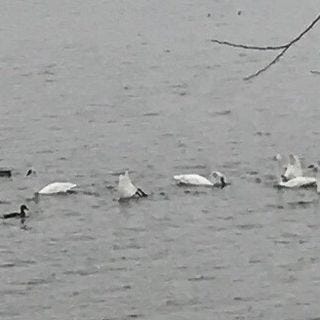# Discover the Majestic Tundra Swans of North America
Written on
Chapter 1: The Journey of Tundra Swans
Every spring, I eagerly await the brief visit of Tundra Swans as they make their way to their summer habitats and breeding grounds. In late fall or early winter, these swans return, journeying to their wintering locations. Their presence at the head of Conesus Lake is something I always look forward to, as they gather in large numbers.
Often, I hear their distinctive calls echoing over our home, a sound that sets them apart from the Canadian Geese that frequent our region throughout the year. The Tundra Swans produce high-pitched cooing sounds, which you can listen to by following this link: Tundra Swan Sounds, All About Birds, Cornell Lab of Ornithology.
Tundra Swans primarily feed on aquatic plants and roots in shallow wetlands but are also known to consume arthropods like crabs, spiders, worms, and insects. Their adaptability allows them to forage on cultivated land and graze in harvested fields during winter months. I've even spotted them foraging in expansive cornfields in a nearby county, which piqued my curiosity about their species.
These swans are strikingly beautiful, adorned with pure white feathers and black legs and feet. A distinguishing feature is their black bills, which sport a small yellow spot near the eyes, known as Lores. However, this yellow marking can be hard to spot from afar due to its size.
Historically, the Tundra Swan was referred to as the Whistling Swan, a name given by the explorer Meriwether Lewis, who noted their whistle-like calls. Lewis provided the first known description of this species during his expedition with William Clark in the early 1800s. Their scientific name is Cygnus columbianus.
As the smaller of North America's two native swan species, Tundra Swans typically measure about 52 inches in length for males and 51.5 inches for females, with males averaging 16 pounds and females around 13.9 pounds. Male and female swans look alike, with the primary difference being their size.
Tundra Swans are monogamous, and once they mate, they remain together for life. In terms of nomenclature, an adult male is called a cob, the female a pen, and the young swans are referred to as cygnets.
Unlike many bird species, Tundra Swan cygnets are born fully feathered and with their eyes open, allowing them to leave the nest almost immediately. This precocial trait is common among various waterfowl, such as Wood Ducks. Although they cannot fly for several months, both parents nurture their cygnets, which remain with them for up to two years.
During the fall migration, Tundra Swans gather in large flocks, often numbering around one hundred individuals. They fly in a V formation, similar to Canadian Geese, reaching speeds of up to one hundred miles per hour as they cover approximately four thousand miles in their migratory journey.
Despite their grace and beauty, Tundra Swans face threats from natural predators, including foxes, weasels, and eagles, which pose risks to their eggs and young. Unfortunately, one of the most significant threats they encounter is climate change. Current scientific predictions indicate ongoing habitat loss, particularly in their breeding grounds. For more information on this issue, visit Audubon's Climate Initiative for Tundra Swans.
Additional threats include the loss of wetlands, pollution, and lead poisoning from lead shot ingested while foraging along river and lake bottoms.
Tundra Swans are truly magnificent beings that enhance the beauty of our environment. I sincerely hope that they, along with many other species, can endure the challenges posed by climate change—and I hope we can, too!

This photo was captured by me during late fall on the shores of Conesus Lake. It represents the last sighting of these magnificent birds before winter set in. I look forward to the end of winter and their return as they migrate back to their summer homes.
Chapter 2: Understanding Tundra Swans
The first video titled "The Elegant Tundra Swan: A Complete Guide" provides an in-depth look at these beautiful birds, exploring their behavior, habitat, and conservation efforts.
The second video titled "Tundra Swan" offers a captivating glimpse into the lives of these swans, showcasing their migration patterns and stunning visuals of their natural habitat.